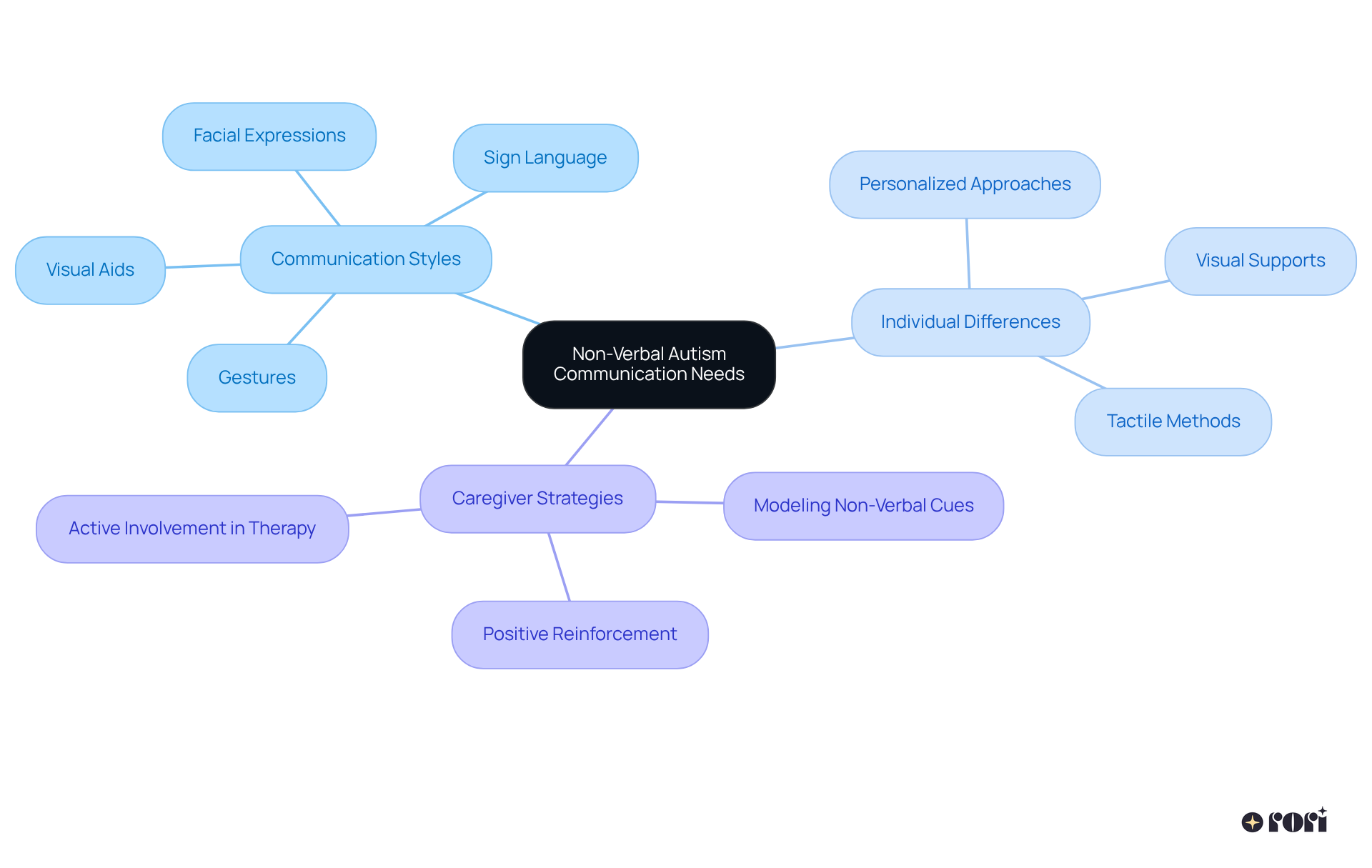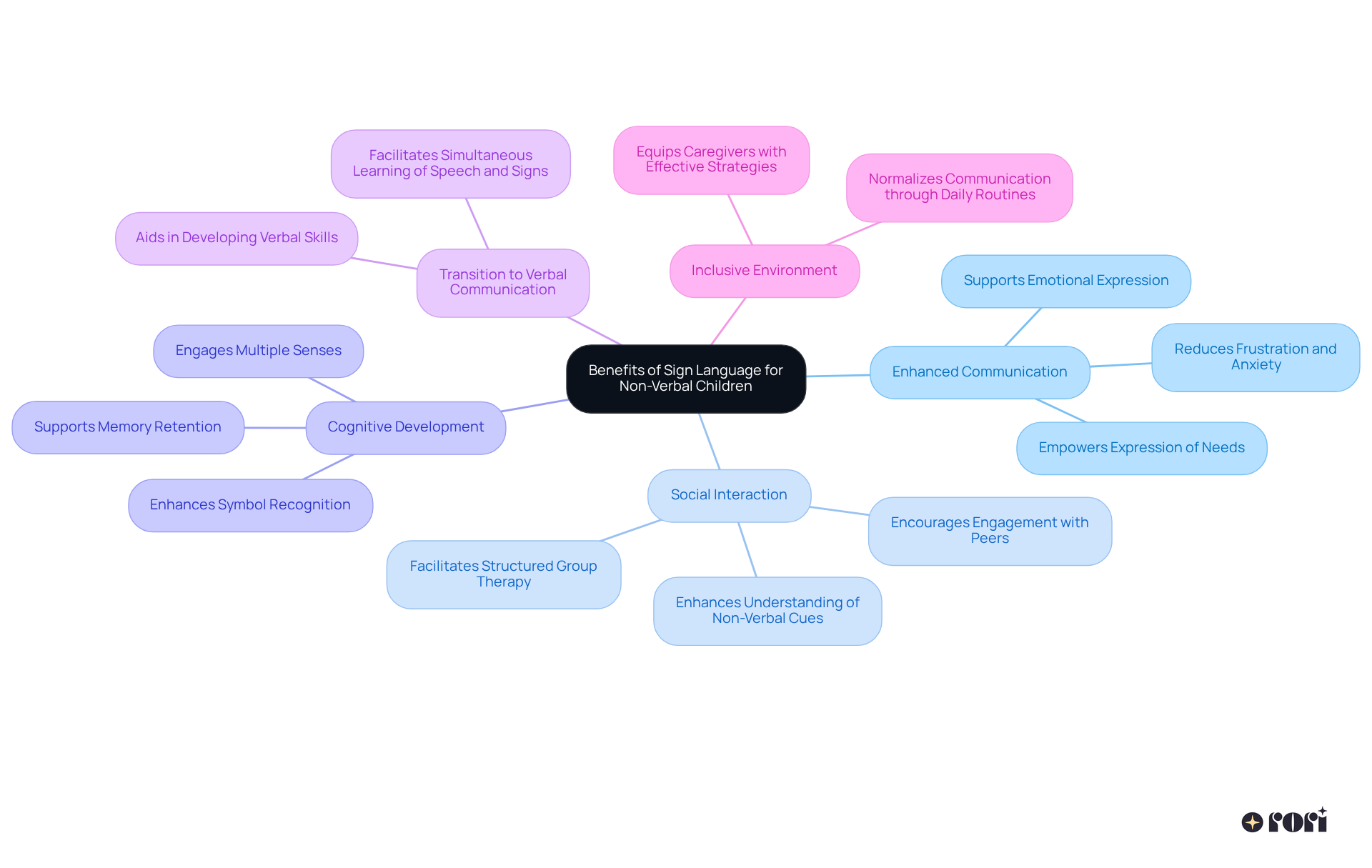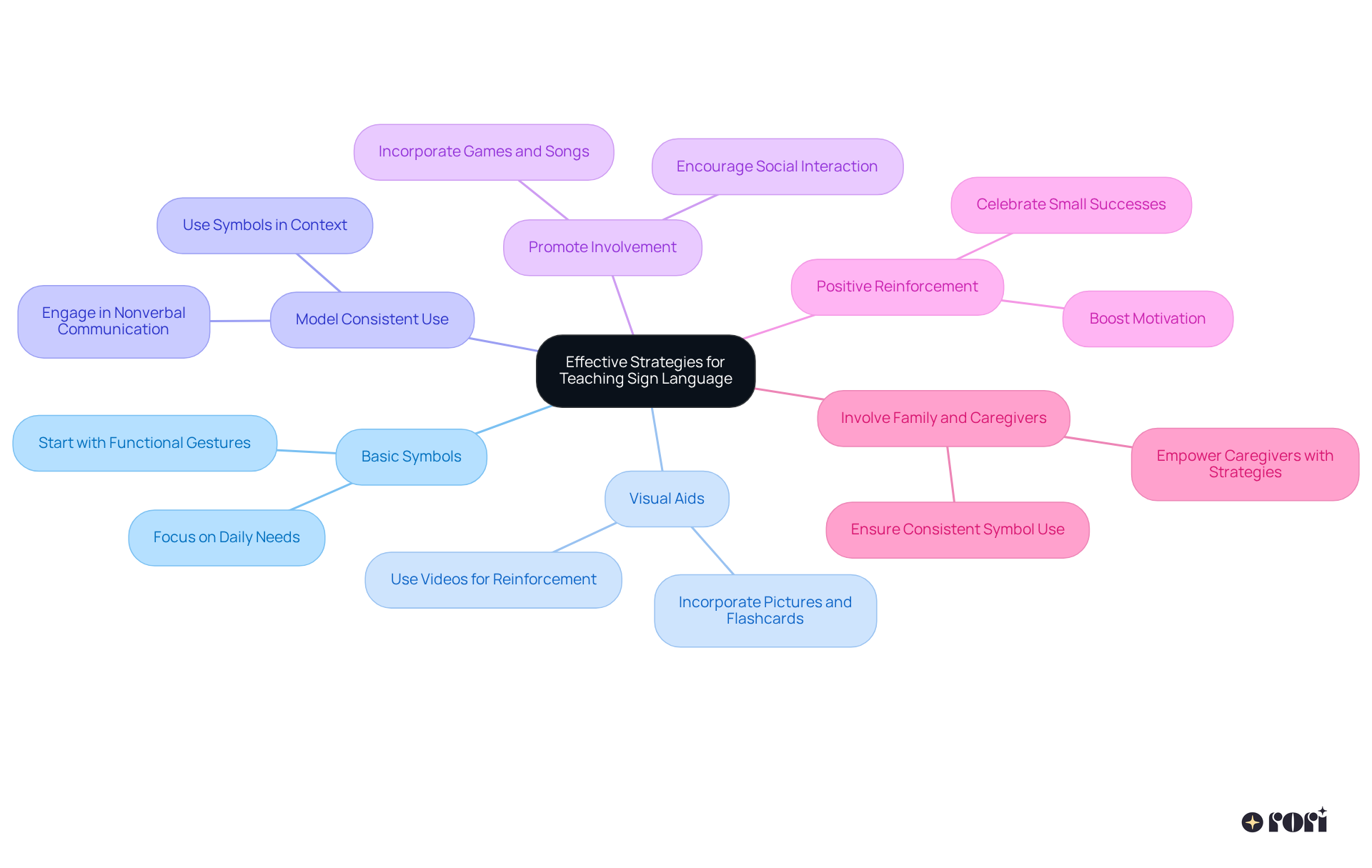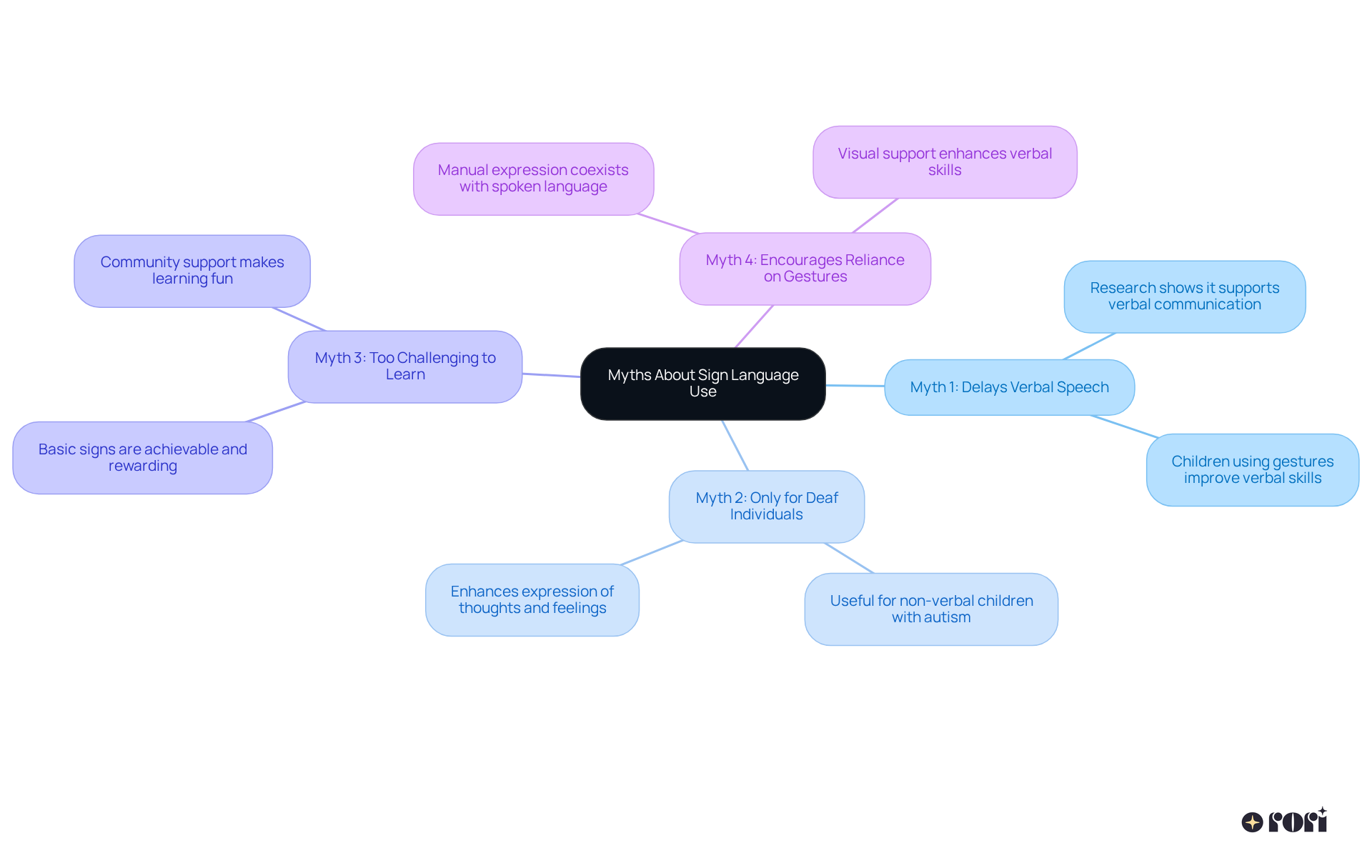This article explores essential strategies for mastering sign language as a communication tool for individuals with non-verbal autism. It highlights how sign language can significantly enhance communication, social interaction, and cognitive development. By outlining effective teaching methods and addressing common myths, it creates a nurturing environment that fosters meaningful connections and promotes the child's overall development.
Let’s dive into why these strategies are so important! Imagine a child who can express their needs and emotions through sign language. This not only helps them communicate better but also boosts their confidence and social skills.
We'll also tackle some misconceptions about sign language, showing that it’s not just for those who can’t speak but a valuable tool for everyone. The benefits of using sign language are profound, creating opportunities for deeper connections and understanding.
As parents, you’re not alone on this journey. Let’s explore this together and discover how sign language can transform your child's communication experience! We’re here to help you every step of the way!
Understanding the communication needs of non-verbal children with autism is crucial in fostering their development and independence. Sign language emerges as a powerful tool, enabling these individuals to express their thoughts and feelings. This bridge can help reduce the frustration and isolation that often accompany communication challenges.
However, misconceptions about its use can create barriers for caregivers and educators. So, how can they overcome these challenges? Let’s explore this together! By effectively implementing sign language, we can enhance communication and social skills in non-verbal autistic children. We’re here to help you every step of the way!
Individuals on the autism spectrum who do not use spoken words to interact are part of non-verbal autism, making sign language for non-verbal autism a vital communication tool. Understanding their expressive needs means recognizing that these youngsters often communicate through gestures, facial expressions, body movements, and sign language for non-verbal autism. It’s so important to observe how they interact with their surroundings and those around them. Many non-verbal individuals have a rich understanding of language but find it challenging to express it verbally, which is why sign language for non-verbal autism can be an effective alternative. This insight is vital for caregivers and educators as they develop effective communication strategies that incorporate sign language for non-verbal autism tailored to each child's unique needs.
Communication Styles: Non-verbal individuals might use alternative methods like pointing, drawing, or using objects to express their thoughts and feelings. These strategies can be game-changers in facilitating understanding and interaction through the use of sign language for non-verbal autism. Educating caregivers on ABA principles gives them the tools to implement these methods effectively, leading to informed decision-making and better behavioral outcomes. Understanding emotions is crucial for accurately gauging their needs, particularly when using sign language for non-verbal autism, which emphasizes the importance of paying close attention to non-verbal cues like facial expressions and body language. This awareness can greatly enhance the caregiver-youngster relationship, empowering caregivers to interpret these cues more effectively by being actively involved in their ward's therapy.
Individual Differences: Each child is unique; some may respond better to visual aids, while others might thrive with tactile methods. Recognizing these individual preferences allows for a more personalized approach to interaction using sign language for non-verbal autism.
By acknowledging these factors, caregivers can foster a nurturing environment that encourages meaningful interaction and a deeper understanding of sign language for non-verbal autism, ultimately enhancing the child's development and independence. Let’s explore this together!

Sign language for non verbal autism provides numerous advantages for non-verbal kids with autism, making it a wonderful way to connect and interact. Let’s explore some of these benefits together!
Ready to take the first step toward a brighter future for your child? 🌟 Register for a complimentary consultation with our caring specialists to customize a developmental plan that meets your loved one’s individual needs. We’re here to help you every step of the way!

Instructing sign language for non-verbal autism to non-verbal youths requires a blend of patience, consistency, and creativity. Let’s explore some effective strategies to implement:
Begin with Basic Symbols: Start with simple, functional gestures like 'more', 'eat', 'drink', and 'play'. These gestures are closely tied to the little one's daily life and needs, making them easier to grasp. Did you know that around 25% of individuals with autism are nonverbal or have limited speech? That’s why these fundamental indicators are so crucial for communication!
Use Visual Aids: Incorporate pictures, flashcards, or videos to reinforce learning. Visual aids help children connect symbols with their meanings, boosting their understanding and memory. The visual aspect of sign language for non-verbal autism can significantly support memory retrieval, especially for individuals with autism.
Model Consistent Use: Regularly use symbols in context during everyday activities. For instance, using the gesture for 'eat' at mealtime helps create strong connections between the gesture and its meaning. Engaging in nonverbal communication, like pointing or tapping to express needs, is a great sign of readiness to learn!
Promote Involvement: Get the young one involved in activities that let them practice gestures, such as games or songs that incorporate hand communication. This interactive approach makes learning fun and encourages social interaction, which is key for emotional regulation. Plus, social skills group therapy led by trained therapists can further enhance these interactions, leading to better skills and relationships.
Positive Reinforcement: Celebrate every success, no matter how small! Positive reinforcement boosts motivation and encourages ongoing learning and engagement. As Rori Care highlights, understanding and using nonverbal cues can significantly enhance their ability to communicate and express themselves.
Involve Family and Caregivers: It’s important that all family members and caregivers consistently use the same symbols. A unified approach creates a nurturing dialogue atmosphere, enriching the young one’s learning experience. Empowering caregivers with ABA principles and strategies is essential, as their active participation leads to informed decisions and better behavioral outcomes, ultimately enhancing family dynamics.
By using these methods, caregivers can effectively teach sign language for non-verbal autism, which greatly improves communication and fosters stronger connections with non-verbal children. Integrating gestures not only enhances communication skills but also reduces frustration and anxiety, allowing individuals with autism to explore their surroundings more comfortably.

While gesture communication offers many advantages, some myths and concerns might hold caregivers back from using it. Let’s take a look at a few common misconceptions:
Myth 1: Sign language will delay verbal speech: Research shows that using sign language doesn’t hinder verbal communication; in fact, it can actually support and enhance it! Many studies indicate that children who frequently use gesture communication often improve their verbal skills more efficiently. Caregivers who understand ABA principles can make informed choices that positively impact their child’s ability to express themselves.
Myth 2: Only deaf individuals use gestural language: However, sign language for non-verbal autism is a fantastic tool for everyone, including non-verbal kids with autism. It provides an effective way to express thoughts and feelings. Understanding this can help caregivers see gestures as an important part of their child’s communication toolkit.
Myth 3: Learning gestures is too challenging: While it does take some practice, many caregivers find that picking up basic signs is both achievable and rewarding. Community support resources can make learning fun and effective, perfectly aligning with the supportive mission of Rori Care - ABA Therapy. Caregiver education programs can boost confidence and ease stress, making the learning journey smoother.
Myth 4: Children will rely on gestures and stop trying to speak: Manual expression can beautifully coexist with spoken language. In fact, many children who use gesture communication also enhance their verbal skills, benefiting from the visual support it provides. Engaged caregiver participation, guided by ABA strategies, can lead to better behavioral outcomes and a more inclusive interaction environment.
By addressing these myths, caregivers can feel more confident about incorporating sign language for non-verbal autism into their child’s communication toolkit. Let’s explore this together, fostering a more inclusive and supportive environment for our little ones!

Understanding and implementing sign language for non-verbal autism is so important for fostering communication and connection with children facing unique expressive challenges. When caregivers recognize the significance of sign language, they can greatly enhance the quality of interactions, paving the way for better emotional and social development for these children.
This article dives into various aspects of non-verbal autism, highlighting the benefits of sign language—like improved communication, social interaction, cognitive development, and a smoother transition to verbal expression. It also shares effective teaching strategies and addresses common myths that might hold caregivers back from embracing this valuable communication tool. By adopting a personalized and informed approach, caregivers can create a nurturing environment that encourages meaningful interactions and supports the child's growth.
Ultimately, embracing sign language for non-verbal autism isn't just about teaching gestures; it's about opening doors to understanding and connection. Caregivers are encouraged to take proactive steps, such as seeking resources and support programs, to empower both themselves and their children. By fostering an inclusive atmosphere that values all forms of communication, the potential for growth and development in non-verbal children can be truly transformative. Let’s explore this journey together!
What is non-verbal autism?
Non-verbal autism refers to individuals on the autism spectrum who do not use spoken words to communicate. They often express themselves through gestures, facial expressions, body movements, and sign language.
Why is sign language important for non-verbal individuals with autism?
Sign language is a vital communication tool for non-verbal individuals with autism as it provides an effective alternative for expressing their thoughts and feelings, allowing them to communicate despite challenges with verbal expression.
How do non-verbal individuals typically communicate?
Non-verbal individuals may use alternative methods such as pointing, drawing, or using objects, in addition to sign language, to express their thoughts and feelings.
What role do caregivers and educators play in supporting non-verbal individuals?
Caregivers and educators should develop effective communication strategies that incorporate sign language tailored to each child's unique needs, enhancing understanding and interaction.
How can caregivers educate themselves on effective communication strategies?
Educating caregivers on Applied Behavior Analysis (ABA) principles equips them with tools to implement various communication methods effectively, leading to better behavioral outcomes.
Why is understanding emotions important in communication with non-verbal individuals?
Understanding emotions is crucial for accurately gauging the needs of non-verbal individuals, as it helps caregivers interpret non-verbal cues like facial expressions and body language.
How can individual differences impact communication strategies?
Each child is unique; some may respond better to visual aids while others might thrive with tactile methods. Recognizing these preferences allows for a more personalized approach to interaction.
What is the overall goal of using sign language and understanding communication needs in non-verbal autism?
The goal is to foster a nurturing environment that encourages meaningful interaction and a deeper understanding of sign language, ultimately enhancing the child's development and independence.